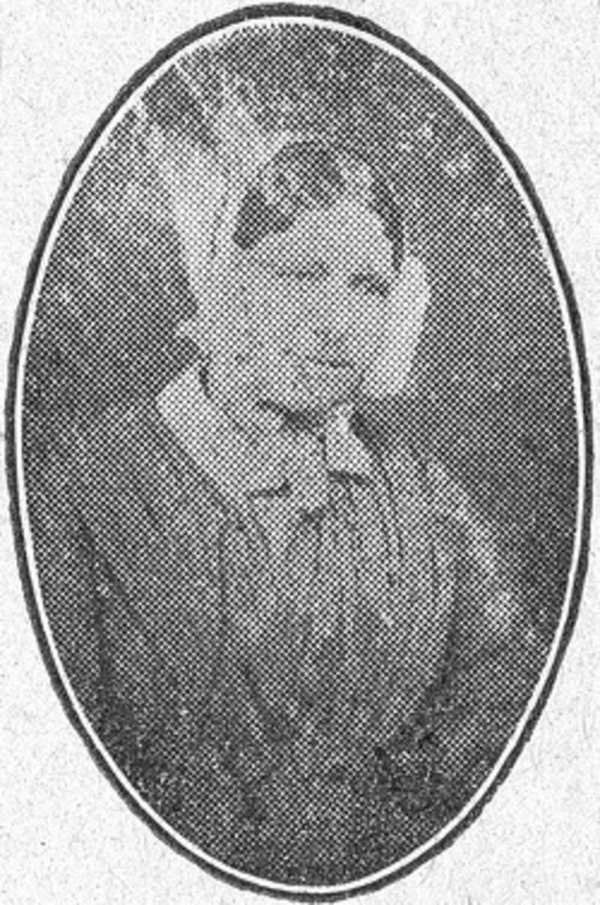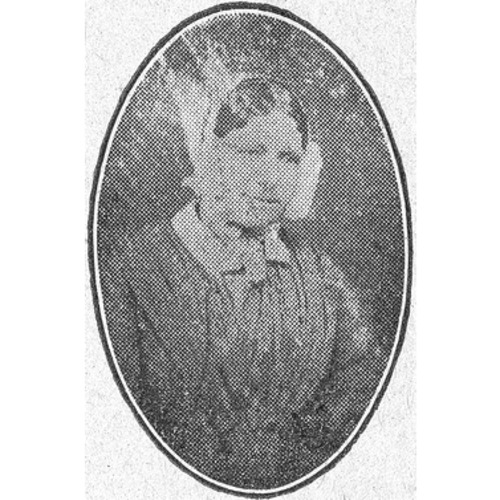
Source: Link
HOERNER, OLYMPE (Tanner), educator and Protestant missionary; b. 3 Oct. 1807 in La Chaux-de-Fonds, Switzerland, daughter of David-Balthazar Hoerner and Marguerite Chanel; m. 10 Dec. 1837 Jean-Emmanuel Tanner, in Germany, and they had one son; d. 4 Nov. 1854 in Pointe-aux-Trembles (Montreal).
Olympe Hoerner, whose father was a pharmacist of German origin, came to the Red River colony (Man.) in 1821 with her parents, her five brothers and sisters, and other Swiss families. These settlers had been recruited at the suggestion of Lord Selkirk [Douglas*] to revitalize the colony, but, faced with innumerable difficulties, many left the region, either to settle on American soil or to return home. The Hoerner family may have chosen the latter course, for Olympe took a position in London, England, as a governess. In this capacity she accompanied Lord Barham’s family to France; there she met a Swiss compatriot, the Reverend Jean-Emmanuel Tanner, and they were married in Germany in 1837. Their son, Charles Augustus, who was to become a Presbyterian minister in Canada, was born in April 1839 in France. Olympe apparently first worked as an evangelist there, but only briefly, because in 1841 her husband was forced to return to Geneva for health reasons, and there he obtained an offer to join in evangelizing French Canadian Catholics.
Interest in the Canadian missions had been awakened in Switzerland around 1830, through the London Missionary Society. A few Swiss evangelists, among them Henriette Feller [Odin*] and Louis Roussy*, began working in the Montreal region in 1835, and the anticlerical demonstrations during the 1837–38 rebellion stirred hopes of converting some French Canadians to Protestantism. Taking advantage of the circumstances, a dozen English-speaking Montrealers of various religious denominations met on 13 Feb. 1839 to found the French Canadian Missionary Society. Its objectives were to recruit francophone pastors, teachers, and evangelists, and to establish schools and centres for worship. Their action was in keeping with the search for unity being pursued as an ideal by the Protestant churches. The society’s constitution contained the rudiments of a common profession of faith, and specified that the evangelists who were appointed must subordinate their denominational ties. From the start the attempt at unification ran into serious difficulties. Church of England ministers refused to cooperate, and the French-speaking Protestant community of Grande-Ligne under Henriette Feller declined to join.
In the year that the society was founded its officers sent James Court and William Taylor* to Europe to enlist evangelists and collect funds. At the end of 1840 four lay recruits arrived in Lower Canada. They were stationed in the Montreal region on the north shore of the St Lawrence, at Belle-Rivière, Petit-Brûlé (Mirabel), and Sainte-Thérèse-de-Blainville (Sainte-Thérèse), for there was an understanding with the Protestants of Grande-Ligne that they alone should proselytize on the south shore. The choice of localities was based in part on the prospects of success, but especially on the proximity of Protestant English-speaking families in sympathy with the cause.
The society as yet had no pastor to administer the sacraments. In response to its request, the committee that had been set up in Geneva to assist with recruitment recommended Jean-Emmanuel Tanner and his wife, who arrived at Montreal in August 1841. After working for a few months in the city, the Tanners settled in Sainte-Thérèse-de-Blainville, where the departure of evangelist Claude Prévost (who has been often referred to as Henri Provost) had thrown the little Protestant community into confusion. Olympe Tanner opened a school in their house, which became a target for the hostility of Catholics. On one occasion people trespassed on their property and the windows of the house were broken. The incident gave the Tanners a chance to show their goodness of heart by asking that the sentence given to the offenders be suspended. Despite this gesture, the school was attended by only “a small number of children.”
Meanwhile Jean-Emmanuel Tanner had been entrusted with coordinating the work of the evangelists. In the spring of 1843 he was asked to move to Montreal and settle in a house large enough to accommodate missionaries passing through the city. His wife made use of the space to start a French class for English-speaking girls. The society encouraged her endeavour, although it stressed that its objectives would be more swiftly attained if she concentrated solely on evangelizing French Canadian Catholics.
At the end of 1843 Olympe Tanner accompanied her husband to Europe on a recruiting trip. They returned on 7 June 1844 with six evangelists. She then resumed her French class, which apparently had continued without interruption while she was away. It is possible that her sister, a Mme Higgs, who occasionally helped the missionary society, took it over in her absence. Probably in deference to the executive body of the society, Olympe gave up the French class in 1845 to devote her time to educating French Canadian girls. She took in three girls as boarders and taught them academic subjects, homemaking, and the Bible; this was the beginning of the institute for girls, which officially opened its doors to nine boarders in May 1846 in the Tanners’ Montreal residence.
With the arrival of the evangelists recruited by the Tanners, the society had 17 missionaries, including wives. It could therefore undertake to enlarge its field of action, particularly since the group now included Louis Marie, an agricultural specialist hired to work on its model farm at Belle-Rivière adjoining the institute for boys. The executive then decided to relocate the society’s main establishments to a recently purchased farm at Pointe-aux-Trembles on a, and to erect a building there that could accommodate the students. It asked Jean-Emmanuel Tanner to become the principal of the boys’ school. In May 1847 Olympe’s school was in its turn transferred to Pointe-aux-Trembles, no doubt to allow the Tanners to live together, but also as an economic measure, for the same teachers would teach both boys and girls, and the girls would get practice in domestic chores.
French Canadian students at Pointe-aux-Trembles received free board and education because the French Canadian Missionary Society counted on this generosity to further its work. English-speaking students had to pay, and were admitted only on accepting the same regulations as the French-speaking students. The program kept the pupils busy from 5:00 a.m., when they got up, to 9:00 p.m., the appointed bed-time. The boys and girls received separately about six hours of instruction daily; as well as mathematics, French grammar, history, natural sciences, and geography, they learned singing or music and studied the Bible. Two or three hours were devoted to study and about two hours to manual training – farm work for the boys and housework for the girls. The latter suspended their studies on Monday afternoons and Saturdays to do the laundry and mending for the schools.
During the early years these schools were on average attended annually by about 50 boys and just under 20 girls, ranging in age from 9 to 23. In February 1849 the executive reported that, since they had opened, the institutes at Pointe-aux-Trembles had helped to train 112 boys and 62 girls, from 78 families and 21 places in Lower Canada. They were sometimes obliged to refuse students or to send the pupils home for a few weeks because there was no money for board and lodging. But the development of the institute for girls was hampered particularly by cramped premises.
When Olympe Tanner moved to Pointe-aux-Trembles, she set up her school and her residence in an old farmhouse adjoining the institute for boys. The building could barely accommodate the 15 to 18 female students housed there in addition to the Tanner family and no doubt also Mme Higgs and her daughter, both of whom taught in the school and assisted its principal. In 1848 an auxiliary committee of English-speaking Montreal women tried without success to collect enough money to build a new school. The sums contributed were sufficient to allow a small structure to be put up, but it apparently did not meet the needs of the Tanner family.
Dissatisfied with their working and living conditions, and probably also with their salary, the Tanners resigned in June 1849, intending to settle in Montreal, where they proposed to continue evangelizing and to open a French school for English-speaking students. The executive could not accept the idea of losing their services and engaged in frantic negotiations. Jean-Emmanuel first suggested that he be given a plot on the Pointe-aux-Trembles farm so that he could build his dwelling there and set up a French school that his wife would run. Finally the committee settled the disagreement by adjusting their stipend. The Tanners were given an annual salary of £75, which was £5 more than the salaries of the other married evangelists. An annuity of £15 sterling, bearing interest, was established in their names to take care of their retirement. In addition to their stipend, at the end of 1851 they were granted free board and lodging. The implication doubtless was that they would be better housed, and in fact at the beginning of 1852 the society took steps towards building the girls’ school and the principals’ residence. Despite financial help from the ladies’ auxiliary committee, the Tanners had to go to the United States in the summer of 1853 to raise funds. The new building was completed that September. Shortly afterwards Olympe Tanner was stricken with a serious illness that led to her death on 4 Nov. 1854, at the point when she might have begun to enjoy the fruits of her labour.
As the years passed, the churches belonging to the French Canadian Missionary Society decided one by one to set up their own organizations to spread the gospel among French Canadians. Thus in 1880 the society had to wind up its operations. For his part, Jean-Emmanuel Tanner had joined the Presbyterian church in 1861. Olympe Tanner may have had an inconspicuous career, living as she did in the shadow of her husband. She none the less exerted a considerable influence on the destiny of the French Canadian Missionary Society, since much of its evangelizing work was based on the education of the young.
ANQ-M, CE1-92, 6 nov. 1854. Arch. de l’État (Neuchâtel, Switzerland), La Chaux-de-Fonds, reg. des baptêmes, 16 janv. 1808. UCA, Biog. files, C. A. Tanner; J.-E. Tanner; French Canadian Missionary Soc., General Committee, minutes, 1848–61 (mfm.). French Canadian Missionary Soc., Occasional Papers (Montreal), 1842–44; Reports (Montreal), 1842–53. Feuille religieuse du canton de Vaud (Lausanne, Switzerland), 1830–60. Missionary Record (Montreal), November 1842–December 1848. E. H. Bovay, Le Canada et les Suisses, 1604–1974 (Fribourg, Switzerland, 1976). R.-P. Duclos, Histoire du protestantisme français au Canada et aux États-Unis (2v., Montréal, [1913]). Paul Villard, Up to the light; the story of French Protestantism in Canada (Toronto, 1928). René Hardy, “La rébellion de 1837–38 et l’essor du protestantisme canadien-français,” RHAF, 29 (1975–76): 163–89.
Bibliography for the revised version:
Ancestry.com, “Germany, Lutheran baptisms, marriages, and burials, 1500–1971,” Württemberg, 10 Dec. 1837: www.ancestry.ca/search/collections/61229 (consulted 18 July 2022). Bibliothèque et Arch. Nationales du Québec, Centre d’arch. de Montréal, P607, 14 juill. 1899.
Cite This Article
René Hardy, “HOERNER, OLYMPE (Tanner),” in Dictionary of Canadian Biography, vol. 8, University of Toronto/Université Laval, 2003–, accessed January 12, 2026, https://www.biographi.ca/en/bio/hoerner_olympe_8E.html.
The citation above shows the format for footnotes and endnotes according to the Chicago manual of style (16th edition). Information to be used in other citation formats:
| Permalink: | https://www.biographi.ca/en/bio/hoerner_olympe_8E.html |
| Author of Article: | René Hardy |
| Title of Article: | HOERNER, OLYMPE (Tanner) |
| Publication Name: | Dictionary of Canadian Biography, vol. 8 |
| Publisher: | University of Toronto/Université Laval |
| Year of publication: | 1985 |
| Year of revision: | 2024 |
| Access Date: | January 12, 2026 |



